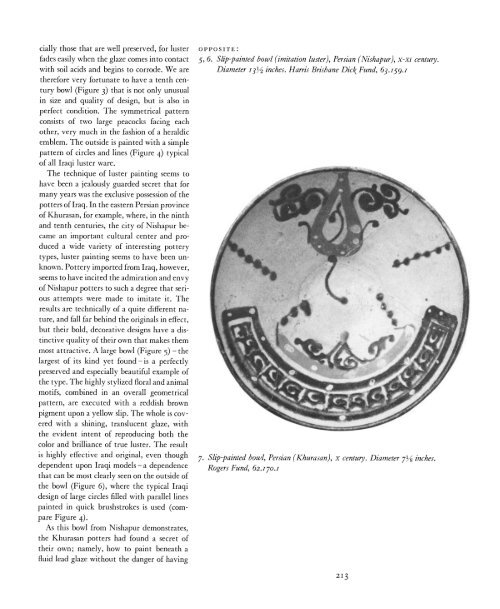Islamic Art: The Metropolitan Museum of Art Bulletin, v. 23, no. 6 ...
Islamic Art: The Metropolitan Museum of Art Bulletin, v. 23, no. 6 ...
Islamic Art: The Metropolitan Museum of Art Bulletin, v. 23, no. 6 ...
Create successful ePaper yourself
Turn your PDF publications into a flip-book with our unique Google optimized e-Paper software.
cially those that are well preserved, for luster<br />
fades easily when the glaze comes into contact<br />
with soil acids and begins to corrode. We are<br />
therefore very fortunate to have a tenth century<br />
bowl (Figure 3) that is <strong>no</strong>t only unusual<br />
in size and quality <strong>of</strong> design, but is also in<br />
perfect condition. <strong>The</strong> symmetrical pattern<br />
consists <strong>of</strong> two large peacocks facing each<br />
other, very much in the fashion <strong>of</strong> a heraldic<br />
emblem. <strong>The</strong> outside is painted with a simple<br />
pattern <strong>of</strong> circles and lines (Figure 4) typical<br />
<strong>of</strong> all Iraqi luster ware.<br />
<strong>The</strong> technique <strong>of</strong> luster painting seems to<br />
have been a jealously guarded secret that for<br />
many years was the exclusive possession <strong>of</strong> the<br />
potters <strong>of</strong> Iraq. In the eastern Persian province<br />
<strong>of</strong> Khurasan, for example, where, in the ninth<br />
and tenth centuries, the city <strong>of</strong> Nishapur became<br />
an important cultural center and produced<br />
a wide variety <strong>of</strong> interesting pottery<br />
types, luster painting seems to have been unk<strong>no</strong>wn.<br />
Pottery imported from Iraq, however,<br />
seems to have incited the admiration and envy<br />
<strong>of</strong> Nishapur potters to such a degree that serious<br />
attempts were made to imitate it. <strong>The</strong><br />
results are technically <strong>of</strong> a quite different na-<br />
ture, and fall far behind the originals in effect,<br />
but their bold, decorative designs have a distinctive<br />
quality <strong>of</strong> their own that makes them<br />
most attractive. A large bowl (Figure 5) - the<br />
largest <strong>of</strong> its kind yet found -is a perfectly<br />
preserved and especially beautiful example <strong>of</strong><br />
the type. <strong>The</strong> highly stylized floral and animal<br />
motifs, combined in an overall geometrical<br />
pattern, are executed with a reddish brown<br />
pigment upon a yellow slip. <strong>The</strong> whole is covered<br />
with a shining, translucent glaze, with<br />
the evident intent <strong>of</strong> reproducing both the<br />
color and brilliance <strong>of</strong> true luster. <strong>The</strong> result<br />
is highly effective and original, even though<br />
dependent upon Iraqi models -a dependence<br />
that can be most clearly seen on the outside <strong>of</strong><br />
the bowl (Figure 6), where the typical Iraqi<br />
design <strong>of</strong> large circles filled with parallel lines<br />
painted in quick brushstrokes is used (compare<br />
Figure 4).<br />
As this bowl from Nishapur demonstrates,<br />
the Khurasan potters had found a secret <strong>of</strong><br />
their own; namely, how to paint beneath a<br />
fluid lead glaze without the danger <strong>of</strong> having<br />
OPPOSITE:<br />
5, 6. Slip-painted bowl (imitation luster), Persian (Nishapur), x-xi century.<br />
Diameter I32 inches. Harris Brisbane Dick Fund, 63.I59.1<br />
7. Slip-painted bowl, Persian (Khurasan), x century. Diameter 78 inches.<br />
Rogers Fund, 62.I70.1<br />
213

















